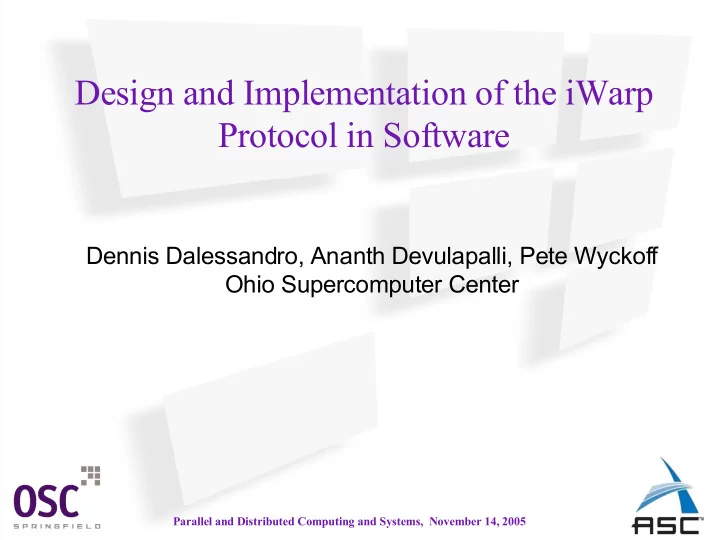

Design and Implementation of the iWarp Protocol in Software Dennis Dalessandro, Ananth Devulapalli, Pete Wyckoff Ohio Supercomputer Center Parallel and Distributed Computing and Systems, November 14, 2005
What is iWarp? • RDMA over Ethernet. Provides Zero-Copy mechanism to move data. Facilitated by protocol offload. • RDMA is what makes Infiniband so special. But Infiniband does not work over Ethernet. • TOE cards provide protocol offload. But TOEs do not provide Zero-Copy. Parallel and Distributed Computing and Systems, November 14, 2005
What is RDMA? Host A Kernel Space N Buffer I User Space C Application BUFFER Host B User Space Kernel Space N Application I BUFFER Buffer C TCP iWarp Parallel and Distributed Computing and Systems, November 14, 2005
What is iWarp cont... • IETF RFCs: Application Application RDMAP. Verbs API Sockets API • RDMA Protocol. DDP. RDMAP • Direct Data Placement protocol. MPA. DDP MPA • Marker PDU aligned framing layer. • Upper level API Transport Transport (TCP) (TCP) Verbs Network (IP) Network (IP) MPI DAPL Data Link Data Link Physical Physical Parallel and Distributed Computing and Systems, November 14, 2005
What is the catch? • Clearly iWarp is a good thing but.... • Downside: Requires special hardware on both ends to take advantage. • Upside: Based on commodity technology that any computer has....Ethernet. • This is where software iWarp comes in! Enable a host to speak the iWarp protocol completely in software. iWarp RNIC can talk to a regular Ethernet NIC. Parallel and Distributed Computing and Systems, November 14, 2005
Why Software iWarp? • Allows a server equipped with an RNIC to take advantage of it even if the other side does not. • Likely only most crucial of servers will be outfitted with RNICs at first. Software iWarp running on clients allows for easy adoption of iWarp. • No benefit realized on the client end running software iWarp though. Point is to benefit the server not the client. Thus server can handle many more connections • Which in reality benefits the clients. Parallel and Distributed Computing and Systems, November 14, 2005
Our Work • Implemented RDMA, DDP, MPA, and a verbs API layer in software. This work based on user space software. Kernel space module recently completed! Need both user and kernel space. • Can successfully communicate with hardware iWarp RNICs from Ammasso. • Utilize existing TCP stack. Requires no system changes. Regular user can install and run, which makes it possible to incorporate into applications. Parallel and Distributed Computing and Systems, November 14, 2005
Performance Overview • Add very little overhead to TCP for small messages. CRC has an effect on larger message sizes. • CPU utilization has been reduced. Sender from 35% to 5%! Receiver from 90% to less than 5%! Results in server being able to scale to many more clients. Parallel and Distributed Computing and Systems, November 14, 2005
Latency 4 Bytes 64 Kilobytes hw to hw 15 609.7 sw to sw (no crc) 62.7 687.5 sw to sw (with crc) 62.2 1401.9 hw to sw 62.8 950.4 sw to hw 61.2 937.9 tcp to tcp 62.7 624.5 *times in microseconds Small message sizes add very little overhead to TCP. • CRC shows effect on 64kB messages. SW and HW combinations show larger latency at 64kB • This is due to CRC. Latency of HW-HW is very good for small messages. • Latency is not the main benefit of iWarp. Lack of overhead is important though. • Parallel and Distributed Computing and Systems, November 14, 2005
Throughput • Key point: Everything bounded by TCP. • CRC Effect: SW-SW without CRC rivals TCP, and HW. With CRC noticeably lower throughput. • SW-HW higher throughput than HW-SW Because HW can respond faster. Parallel and Distributed Computing and Systems, November 14, 2005
Sending Side System Load 75 70 sw->sw 65 crc • CRC Effect sw->sw no 60 crc 23% extra load 55 tcp->tcp hw->sw System Load (%) 50 • Overhead ontop of TCP/IP 45 40 CRC – 35% 35 No CRC – 17% 30 25 • Improvement with HW->SW 20 30% Decrease! 15 10 5 0 Parallel and Distributed Computing and Systems, November 14, 2005
Receiver Side System Load • Receiving is costly 100 Nearly 90% in all tcp and sw 90 cases. 80 • If receiver is hardware 70 Makes no difference if sender System Load (%) tcp->tcp is hardware or software! 60 sw->sw crc Exactly what we want! sw->sw no 50 crc hw->sw • Why hw->hw more load than 40 sw->hw hw->hw sw->hw? 30 hw->hw gets more done. 20 In sw->hw, the hw has to wait for slow sw to catch up. 10 0 Parallel and Distributed Computing and Systems, November 14, 2005
Thanks! • Software available soon. Both user and kernel space implementations. Email for more info. • Any Questions? http://www.osc.edu/~dennis/iwarp Dennis Dalessandro dennis@osc.edu Parallel and Distributed Computing and Systems, November 14, 2005
Recommend
More recommend